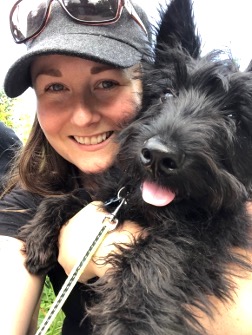By Lindsey Thomson
As a (cisgender, white) bisexual woman, my gender expression has become more intentional and varied as I have come into my bisexual identity and navigated different romantic relationships and social contexts, all while trying to hang onto and express my bisexuality.
As I grew up and discovered my queer identity in my early 20s and fell in and out of romantic relationships with people of different genders, I noticed some curious preferences for my own gender expression began to emerge. Shortly after getting together with my first girlfriend and coming out to myself and others for the first time, I felt a real desire to look queer and integrate into queer communities and cultures. My hair eventually got shorter, yet I was still often doubted as queer when I went to queer clubs. On the other hand, my girlfriend and I received a lot of unwanted attention from men in mainstream bar who assumed our affection for one another meant that we were seeking their attention.
Fast forward to my next romantic relationship, which happened to be with a queer man. I was faced with the new challenge of my bisexuality being erased in a different way. I was assumed to be straight again—only this time my queer identity, which had come to mean so much to me, was ripped away. I joined bisexual social and support groups and made a point of going to queer clubs with my newfound bisexual friends and experimenting with clothing in a conscious way—sometimes “femming it up”with a dress, and other times “dressing it down” with a T-shirt, vest and jeans. No matter who my partner was romantically, or where I was, I tried my best to be seen as bisexual, which often required deliberately coming out to be read accurately.
Recent research investigating gender expression and the experiences of bisexual women in same- or different-gender relationships echoes and validates many of my own experiences. A 2018 study by Daly, King, and Yeadon-Lee asked 19 bisexual women in the United Kingdom to keep a diary and take part in phone interviews about their gender expression over time. All participants were in a monogamous relationship at the time, or “desired to be in one.”
Women in different-gender relationships were more likely to wear clothing and hairstyles that could be interpreted as “butch,” or more stereotypically lesbian, to make their bisexual identity visible. Many women intentionally chose these gender expressions because they wanted to be “read and decoded” as queer, despite being with a different-gender partner.
On the other hand, women in same-gender relationships were more likely to feminize their appearance, choosing clothing and hairstyles that pushed back against stereotypes of lesbian women as butch, and enjoying the idea that this may be disorienting for people with binary expectations around gender and sexuality. At the same time, women were aware that appearing in traditionally feminine ways may be read as less “authentically” queer, and in the context of queer clubs they often felt compelled to physically demonstrate affection for their same-gender partner to concretely display their queerness.
This shows that many bisexual women intentionally use varied gender expressions as a tool to “keep alive” a bisexual identity across relationships and social contexts. The stereotypical (and monosexist) ideas that masculine/butch gender presentation = lesbian, and feminine gender presentation = heterosexual motivates bisexual women to make strategic choices that shift across social contexts depending on which aspects of their sexuality they wish to highlight for which “audiences.” The authors note a distinct challenge in presenting a clearly bisexual gender expression given that there is no one distinctly bisexual style or common gender expression. Bisexual women were also considered “chameleons,” showing fluidity in their gender expression. Bisexual women deliberately chose when, why, and with whom to embody femininity in particular ways to authentically express different parts of their sexuality. Overall, many bisexual women seem to be comfortable switching between gender expressions deemed feminine/heterosexual and butch/lesbian.
Gender expression also took into account whether participants were “out” as bisexual with certain people or within particular contexts. This led the study’s authors to wonder if bisexual women were reinforcing assumed binaries of straight and gay by switching gender expressions. I don’t agree with this interpretation; it is clear that bisexual women used gender expressions that were the opposite of what may be expected across social contexts and pushed back against norms. In my view, bisexual women use different gender presentations to carve out new space for non-monosexual queer identities while employing gender presentations that are recognizable across heterosexual and homosexual contexts alike.
Regardless of the gender of one’s partner, it is clear that being read as bisexual is important for many bisexual women. Playing with feminine and masculine gender expressions are intentional ways of resisting and disrupting binary assumptions of heterosexist and monosexist cultures. This is a very intentional and complex process that demonstrates sophisticated understandings of other’s automatic and mistaken assumptions that conflate gender expression and sexuality in stereotypical ways. Bisexual women’s gender expressions are more complex and varied than mainstream heterosexual and homosexual sub-cultures account for. Our gender and sexuality exist in relation to other people who are romantic partners, “audiences” who make up the social contexts in which we move in and out of, the social norms that govern how others interpret us, and where we live and belong as undeniably queer people.
References
Daly, S.J., King, N., & Yeadon-Lee, T. (2018). “Femme it up or dress it down”: Appearance and bisexual women in monogamous relationships. Journal of Bisexuality, 18(3), 257-277.
Lindsey Thomson lives in Guelph, Ontario, Canada, with her wife CJ, two dogs, and a 29-year old turtle. She is a white settler and late-discovered autistic bisexual woman who is a specialist in community-engaged research and first year PhD student at University of Guelph. She is very passionate about the role of collaborative research in social justice.

